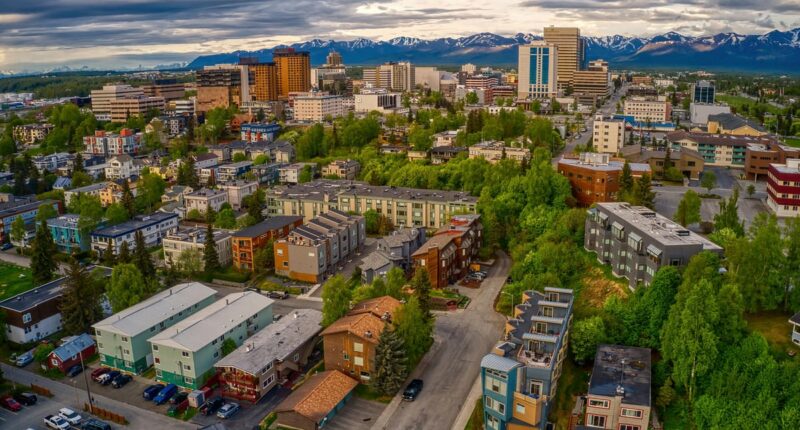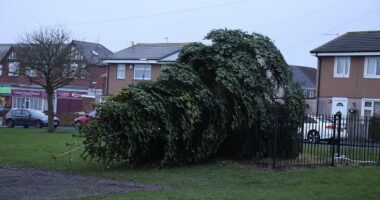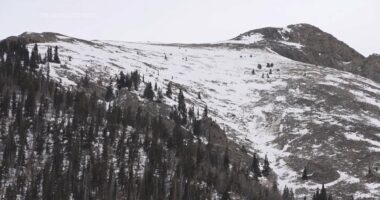Share this @internewscast.com
On Thursday, Alaska experienced a significant seismic event that rattled the city of Anchorage, which is home to approximately 300,000 residents. The earthquake, recorded at a magnitude of 5.4, struck at 9:30 a.m. local time (2:30 p.m. ET) in a remote coastal area, situated about 29 miles southeast of Fox River and roughly 110 miles south of Anchorage, according to the US Geological Survey (USGS).
The tremors were notably felt across Anchorage, with over 2,000 people in the region reporting the sensation of shaking. This event was followed closely by a smaller tremor, registering at a magnitude of 2.6, detected near the same epicenter just five minutes later.
In the aftermath of the quake, the USGS has projected an 87 percent likelihood of experiencing an aftershock of magnitude 3 or higher. There is also a 47 percent chance for a magnitude 4 or higher aftershock and a 12 percent chance for another earthquake reaching a magnitude of 5 within the upcoming week.
This seismic activity occurred along the eastern Aleutian arc, which is a part of a vast 1,864-mile chain of islands and submarine trenches. This arc extends from the Gulf of Alaska all the way to Russia’s Kamchatka Peninsula, making it a notable zone for geological activity.
The agency predicted an 87 percent chance of an aftershock magnitude 3 or higher, 47 percent for magnitude 4 or higher and 12 percent for another magnitude 5 earthquake in the next week.
The earthquake occurred along the eastern Aleutian arc, part of a 1,864-mile chain of islands and underwater trenches stretching from the Gulf of Alaska to Russia’s Kamchatka Peninsula.
Here, the Pacific Plate slides beneath the North American Plate, generating intense seismic activity and frequent megathrust earthquakes.
This is a developing story… More updates to come.

The US Geological Survey (USGS) recorded a 5.4 magnitude quake at 9:30am local time (2:30pm ET) in a remote coastal area about 29 miles southeast of Fox River and about 110 miles south of Anchorage

The agency reported that shaking was felt in Anchorage. More than 2,000 people in the region reported feeling the tremors
The eastern Aleutian arc, which includes the Fox Islands near the quake’s epicenter, is particularly active due to near-perpendicular convergence and subduction beneath thick continental rock.
This region has a history of devastating quakes, including the 1964 magnitude 9.2 Prince William Sound earthquake, the second largest ever recorded, which caused widespread damage in Anchorage and triggered a Pacific-wide tsunami.
Seismic activity along the Aleutian arc results primarily from thrust faulting along the interface of the Pacific and North American plates, as well as deformation within the subducting slab.
While the region experiences moderate and large quakes every year, certain areas, such as the Shumagin Islands to the east, have not seen major ruptures recently, though risks remain.
One local shared on X: ‘Good-sized earthquake here in Alaska.
‘I hear it was around Fritz Creek, so I felt the rolling and a good-sized crack and final shake.’
Alaska experienced a record storm surge this month, when remnants of a typhoon battered the northwestern region, where thousands of people had to be airlifted to safety.
The coastal villages of Kipnuk and Kwigillingok were among the hardest hit, with homes completely demolished and submerged.

In one of the most significant airlifts in Alaska’s history, hundreds were flown about 500 miles to Anchorage, after a shelter in the regional hub city of Bethel was filled with dozens of evacuees
Typhoon Halong was moving in the Pacific near Japan the week before, which would have been equivalent to a Category 4 hurricane should it have made landfall.
The typhoon remnants ripped through Alaska on Sunday, unleashing water levels more than six feet above the highest normal tide line in some areas.
However, remnants of the storm rippled across the Pacific and fueled turbulent weather heading toward Alaska.
As it moves into the North Pacific, the fast-moving jet stream absorbs the typhoon’s energy, intensifying storms along the storm track.
This phenomenon, caused by ‘recurving typhoons,’ can send far-reaching effects across the ocean.
In one of the most significant airlifts in Alaska’s history, hundreds were flown about 500 miles to Anchorage, after a shelter in the regional hub city of Bethel was filled with dozens of evacuees.

The coastal village of Kipnuk was among those hit the hardest. Pictured is the community before the typhoon

Officials on Thursday said 121 homes were destroyed in Kipnuk (pictured after the typhoon), but all people have been accounted for
In Kwigillingok, the US Coast Guard rescued two dozen people from their homes after the structures floated out to sea in high water.
Ella Mae Kashatok, 67, was found dead in Kwigillingok, and authorities on Monday night called off the search for two men, Chester Kashatok, 41, and Vernon Pavil, 71, after their home was swept away.
Officials on Thursday said 121 homes were destroyed in Kipnuk, but all people have been accounted for.
Cellphone service had been restored in Kwigillingok by Thursday, authorities said, and restrooms were operational at the school there, where about 350 people had sheltered overnight Tuesday.
Damage was also serious in other villages. Water, sewer and well systems were inoperable in Napaskiak, according to a statement from the Federal Emergency Management Agency.
Jeremy Zidek, a spokesperson with the state emergency management office, said he did not know how long the evacuation would take, explaining that authorities were looking for additional shelters.
The aim is to get people from congregate shelters into hotel rooms or dormitories, he said.
















